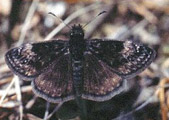Native Plants
Search for native plants by scientific name, common name or family. If you are not sure what you are looking for, try the Combination Search or our Recommended Species lists.
Aquilegia chrysantha var. hinckleyana
Aquilegia chrysantha A. Gray var. hinckleyana (Munz) Lott
Hinckley's Golden Columbine, Yellow Columbine, Hinckley Columbine, Capote Columbine
Ranunculaceae (Buttercup Family)
Synonym(s): Aquilegia hinckleyana
USDA Symbol: AQCHH
USDA Native Status: L48 (N)
Hinckley columbine is currently considered a variety of Aquilegia chrysantha. Its diagnostic features are its petal blades, which are shorter but not narrower than in other varieties of its species at 2 cm long and 16 mm wide, and its tendency to have twice-divided leaves, fewer than the three divisions of other varieties of A. chrysantha. Its foliage is as fern-like and delicate as that of other columbines, and its canary yellow flowers are prominent and spurred. It grows to three feet tall and is endemic to a single site: Capote Falls in the Sierra Vieja Mountains of Presidio County, Texas.
Aquilegia chrysantha var. hinckleyana is one of many yellow columbines popular in the nursery trade, but it is truly rare in the wild, native only to a single waterfall in far west Texas. Like other golden columbines, it is valued for its shade tolerance, attractive foliage, and clear yellow flowers. Columbines are short-lived perennials that reseed to replace mother plants where seed is allowed to mature and drop. They also hybridize freely between species and varieties, so plants sold as "yellow columbine" or "golden columbine" likely contain genetic material from varied sources.
The genus name "Aquilegia" comes from the Latin "aquila" which means "eagle" and refers to the spurred petals that many believe resemble an eagle's talons.
Plant Characteristics
Duration: PerennialHabit: Herb
Leaf Retention: Semi-evergreen
Leaf Shape: Obovate
Leaf Venation: Palmate
Leaf Pubescence: Glabrous
Leaf Margin: Lobed
Leaf Texture: Smooth
Breeding System: Flowers Unisexual , Monoecious
Fruit Type: Follicle
Size Notes: Up to about 3 feet tall.
Leaf: Glaucous green
Flower: Sepals 17 mm wide. Petals 2 cm long petal blades 16 mm wide.
Fruit: Green to dark gray follicles, black seeds 13-18 mm follicles, 2 mm seeds
Bloom Information
Bloom Color: YellowBloom Time: Apr , May
Distribution
USA: TXNative Distribution: Capote Falls in the Sierra Vieja Mountains in Presidio County in west Texas
Native Habitat: Moist places beside a waterfall
Growing Conditions
Water Use: MediumLight Requirement: Part Shade , Shade
Soil Moisture: Moist
Cold Tolerant: yes
Heat Tolerant: yes
Soil Description: Rich, moist, well-drained, slightly acid soils. Will grow in somewhat alkaline soil.
Conditions Comments: Popular and gorgeous spring bloomer when given preferred growing conditions of good, well-drained soil, part shade, and adequate moisture. Though they tolerate some heat, Southwestern yellow columbines become susceptible to spider mites and aphids in very hot, arid conditions.
Benefit
Use Ornamental: Good for spring color in shade gardens, with semi-evergreen foliage decorative much of the yearUse Wildlife: Attracts moths, butterflies, and bees.
Conspicuous Flowers: yes
Interesting Foliage: yes
Attracts: Birds , Butterflies
Larval Host: Columbine Duskywing
Nectar Source: yes
Deer Resistant: Moderate
Butterflies and Moths of North America (BAMONA)
|
Columbine Duskywing (Erynnis lucilius)  Larval Host |
Propagation
Propagation Material: Clump Division , SeedsDescription: Shallowly sow seed in late fall or divide mature plants in late summer. Clump division best done when dormant and is not as successful as seed propagation.
Seed Collection: Collect seed in late April, May. Be sure that the plants you collect seed from are isolated from other Aquilegia species because they cross easily. Seeds may ripen and be shed before the pod has turned brown. If seeds in greenish follicles are black, they are ready to collect. Cut the fruiting stalk and keep in a dry bag for a few days until the seeds shake free.
Seed Treatment: Sow seed in fall as soon as temperature drops and in spring before the worst heat. Will germinate in summer, but not as well and plants struggle more. Stored seed must have a moist, cold period to break dormancy.
Commercially Avail: yes
Maintenance: Remove spent foliage during growing season. Keep soil moist but not wet to avoid rotting crowns. Aquilegia species tend to hybridize when grown with other Aquilegia species. To keep this variety pure and true to flower color, keep other Aquilegia species far apart to avoid cross pollination.
Mr. Smarty Plants says
Planting shade plants in 100+ weather
June 25, 2009
I was planning on planting some columbines in a barrel and Turk's Cap and Coralberry in my yard, but hadn't counted on the extreme heat this early in the summer. Is it okay to plant these things as...
view the full question and answer
From the National Organizations Directory
According to the species list provided by Affiliate Organizations, this plant is on display at the following locations:Lady Bird Johnson Wildflower Center - Austin, TX
NPSOT - Native Plant Society of Texas - Fredericksburg, TX
NPSOT - Austin Chapter - Austin, TX
NPSOT - Williamson County Chapter - Georgetown, TX
Bibliography
Bibref 1186 - Field Guide to Moths of Eastern North America (2005) Covell, C.V., Jr.Bibref 1185 - Field Guide to Western Butterflies (Peterson Field Guides) (1999) Opler, P.A. and A.B. Wright
Bibref 318 - Native Texas Plants: Landscaping Region by Region (2002) Wasowski, S. & A. Wasowski
Bibref 1233 - Rare Plants of Texas: A Field Guide (2007) Poole, J. M.; Carr, W. R.; Price, D. M.; Singhurst...
Search More Titles in Bibliography
Additional resources
USDA: Find Aquilegia chrysantha var. hinckleyana in USDA PlantsFNA: Find Aquilegia chrysantha var. hinckleyana in the Flora of North America (if available)
Google: Search Google for Aquilegia chrysantha var. hinckleyana
Metadata
Record Modified: 2022-09-17Research By: MWJ, GDG